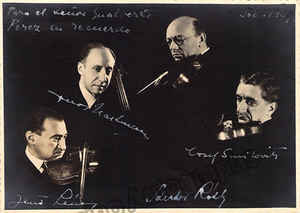
Back in late July of 1983, Janos Sebestyén the harpsichordist thumbed through his little black book and suggested I call an old scholar who had been a violist in the ancient Waldbauer-Kerpely String Quartet. Eager to ask him about Irén Marik and Etelka lurryreund he received me at home and spoke a greeting to Nicholas Milroy, Etelka’s son who had fled from Hungary around 1940:
After asking him about Ignaz Friedman, whom he heard and knew somewhat, my burning curiosity was if he could recall Debussy’s one visit and concert with Molnar’s quartet on 1 December 1910 in Budapest. They played Debussy’s String Quartet and Rose Féart, who had taken the role of Melisande the previous year in London, sang the Fêtes galantes and Pensées lyrics with the composer at the piano. Debussy played his Children’s Corner Suite and pieces from his Images and Estampes: Pagodes, Hommages à Rameau, and Jardins sous la pluie.
My inadequate German aside, he eagerly recalled the event, mentioning how pleased Debussy was with their performance of his quartet and comments on how he played his solos :
As Molnar had known
and her older step-brother Robert, a close associate of Liszt and Brahms, there was more to cover:
Molnar told of numerous rehearsals for Bartók’s String Quartet No. 1 which they premiered, saying that by the end they knew the work from memory. Putting Debussy and the classics aside he motioned me over to a bookshelf. Having no idea what awaited me, I turned off the cassette recorder and followed him to a shelf of red hardbound volumes. Eyeing a few, he reached out for one, flipped to a page and began singing a folk song he had collected before World War I, as he was then accompanying Bartók and Kodaly on their field work and was moved to share this treasure he encountered in a remote village in what is now Romania.
A few days ago while researching Debussy’s trip to Budapest, translations of Molnar’s published comments were contained in a tasty article by Gergely Fazekas entitled “Unhealthy” and “Ugly” Music or a ‘Compass Pointing towards a Purer Art of Superior Quality’? published in 2008. To put it mildly, Molnar was not thrilled with Debussy’s music, as his close relationships to Kodaly and Bartók had a greater impact on his understanding of new musical directions.
On Debussy coaching the quartet, Molnar writes:
He agreed with everything, remarked only two things in the Andante. At the end of the climax (in the middle section) he found the little crescendo of the phrases not expressive enough. He sang the melody and made all the phrase endings pass into forte, then at the beginning of the next wave sank back into being piano. At another place he said: ‘I would like you to play it more purple.’
Five years later and greater familiarity with Debussy’s music, another Molnar article appeared:
I have to divide Debussy’s faults into two groups if I want to be fair with him. The first group will contain the features I personally didn’t like; the second will contain the undeniable faults.
. . . to cut my particular criticism short, I just hate it when sturdy, vigorous Frenchmen play at being irritable, oversensitive creatures with a world view that wraps a mystically flickering universe in a pink veil. Incompetence often resorts to pompous sophistication to make up for a lack of wholesome ideas.
When a flurry arose, Molnar retracted: “I became aware that the ‘debussysts’, i.e. those who think of their prophet not without bias but in a fever of excitement caused by a half extinct theme of fashion, were not happy with my essay.”
Soon after he was approached by Kodaly: “It’s as if you were passing yourself off as his former lover.”
No wonder Molnar was eager to move over to the folk song anthologies! Four months after this visit, Molnar was gone.
While the Waldbauer-Kerpely were never recorded, the first evidence of how a Hungarian string quartet approached Debussy’s masterpiece comes through the Lener Quartet, captured in London on 15 March 1928.

Their first violinist Jeno Lener was born in 1894 and may have attended the Debussy event but certainly the older group’s members were teaching and available to advise the Leners.
I.
II.
III.
IV.
©2017 Allan Evans

Great stuff! Love the “more purple” instruction.
The Andantino’s crescendos to piano mentioned by Molnar are not consistent in the score (and are partly different in the autograph). When those phrases begin, as the middle section nears it conclusion, the piano beginnings are indicated, but not the fortes after the hairpin crescendos. Then, the fortes after the hairpins are indicated, but not the piano beginnings! One supposes the idea is to build up the excitement level. Still, one could surmise that a hairpin followed by another (or a couple more) hairpins requires a piano beginning each time. Was it Bülow who said “crescendo means ‘piano’ ”
Every conservatory string quartet who attempts the Debussy probably requires similar coaching as that received by the Waldbauer-Kerpely in this section!